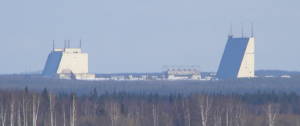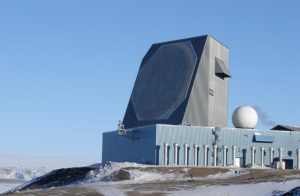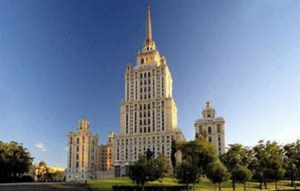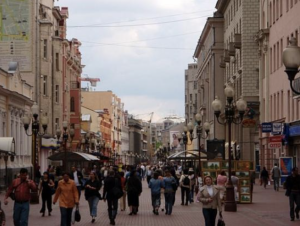In 1990, as an exchange officer serving in the State Department, I was involved in arms control negotiations and treaty compliance issues between our country and the Soviet Union. One aspect was the a diplomatic “tit for tat” unspoken rule – whatever we allowed or did – they did.
Under the ABM Treaty we constantly met on compliance issues and a “big” one at the time was the legal placement of Long-Range Phased Array (LPAR) radars. They were by treaty to be on each’s periphery and facing “out.” They complained about our upgraded one at Thule, Greenland as not being on our soil (we said it was “grandfathered” before the treaty and could be upgraded). We complained about theirs at Krasnoyarsk as not being on the periphery and overlooking Siberia (in truth their construction of such massive buildings had to be not on permafrost and its location may have been chosen for that reason.)

In the relaxed tensions after the fall of the Berlin Wall, we engaged in “confidence building measures” with our Soviet counterparts. One such was the idea of trips to each other’s LPARs to demonstrate only early warning capabilities. In the Fall of 1990, we engaged in one that I had a part in developing. We took them to Thule and they took us to Pechora above the Arctic circle in Russia. Both radars had essentially the same capability but were quite different in size and construction. Since theirs was clearly “legal” then we got the added admission that ours at Thule was too – reciprocity in action.

We went first and hosted them in Washington for a week of sightseeing, shopping, and meals. Their delegation was populated, as was ours, with intel and military experts and not the standard diplomatic types. That was interesting as most had never traveled to the West before and exposure to our country was quite the shock.
We put them up at the Dulles Hilton and took them to the Tysons Mall for a shopping experience. They thought the mall was a “Potemkin Village.” (A Potemkin Village was a Russian Czarist era phony “show place” created to deceive the viewer.) So, we took them to the Springfield mall the next day to show them the reality of the commercial shopping. The DC area traffic also amazed them – so many privately- owned vehicles of all types. They could not believe the abundance in the stores – or the wide variety of products.

We then flew them to the US base at Thule, Greenland with the Danish Embassy Deputy Chief of Mission along to further emphasize the “legality” of the Thule radar although not on “our territory” but on Danish territory.
Soon it was our turn and we went to the Soviet Union for a week of sightseeing and dining in Moscow – followed by a flight to Pechora. It was eye opening as the Soviet economic system was still in place – although the black market thrived.
Our Russian hosts were very accommodating allowing us the same ability to see and even video things at the sites we had given them. So, we saw the socialist paradise at its best. A few anecdotal events were illuminating – and central control of economy exposed. They needed a cost mechanism called “price.”
My first observation was at a dinner at our hotel, a Stalin-era structure. We could not get service or the attention from any waiter, and those who did around us got it very slowly. The waiter got paid whether he served us, or did not serve us, I guess. We loudly complained that we thought that our host (a KGB general) would not be very pleased with our treatment. We were then served immediately.
Our rooms were quite spartan. The toilet paper was soft as a paper bag. We had brought several rolls of our own and these proved to be very well received “tips” for the maids. The floor had an old woman seated in the hall. Our room keys were tied to a very large object and we had to give them to her when we left. I guess so they could be sure when we were out and were free to “inspect” our rooms. Also, there were no shower curtains around the tub and shower. This concerned our female members of the delegation.

Going to dinner in Moscow, we noticed the embassy van had the windshield wiper rubber blades removed. Apparently, these were in short supply in the community and would be taken if left on the vehicle. As currency rates were grossly inflated officially (rubles were worthless except “officially”), we had to be very careful of the use of dollars and rubles. So, we also carried Marlboro cigarettes, a very favorite of the many chain-smoking Russians. A few packs were offered to bystanders to watch over our vehicle while we dined in the restaurant.
Our shopping trip was not to GUM (state department store in Red Square) but along the Arbot. A street allowed to trade in basically black market and bartered exchanges. There were many lines along the state shops and stores with many empty shelves. Folks would line up when any shipment came into a state store. For instance, if boots arrived all would be gone in a moment – even if the customer did not need boots or they were not his size. They were material for bartering for what he did need.

One very interesting site was a Pepsi-Cola vending machine. The Soviets had purchased the rights to bottle it as an alternative to the national drink – vodka. But the system had its planning flaws as there was a shortage of paper cups. So, there was a metal dipper chained to the machine as a drinking cup. One dropped in the kopeks and used the dipper to catch the Pepsi and drink from it. There were not many takers for the community ladle.
We spent some time at the old American Embassy. The newly constructed one could not be used for any sensitive business as the Russian and Polish construction crews had managed to make listening devices part of the concrete pour. The new one did have housing, a bowling alley, and recreation areas. During the week, I observed a road repair crew fixing a single pothole in the street we crossed each day. It was probably an hour job, but these guys managed to take four days – no incentive to getting the job done early.
Much of the trip dealt with information gathering on their radar capabilities and answering our questions on their massive structures. Suffice it to say, the separate transmitter and eleven-story receiver buildings housed massive tubes and floors of old 1960s computer racks. They essentially got the same definition on their screens as our smaller arrays and laptops, but at what a cost! They simply did not have cost or efficiency measures to worry about. And all designs were the same, no matter where they were built. I used the restroom on the top 11th floor at Pechora site and it would not flush. Embarrassed, I reported the problem to my escort. He had a soldier go down and get a bucket of water. Apparently, the local water tower was well below the 11th floor level – but the state design called for a restroom on each floor!
So, as we contemplate any socialist state these days, we must beware of central planning, and its consequences and inefficiencies. Incentive is lost and the lack of the simple valuable element called “real price” makes for poor allocation of resources.
Thanks, Wayne, well done; glad you shared these memories! This is an excellent primer on the effects of socialism and a very enjoyable read! Your article, as well as the movies “Lives of Others,” “Chernobyl,” and “Commander” should be required reading/viewing in American schools.
Wayne, Thanks for sharing this. I enjoyed the read. The workers who were filling in the pot hole are a prime example of the Russian claim of 100% employment. A one person job done by a few. They are all paid by the State, hence the claim.
Great story!
Thanks, Wayne! A good lesson for anyone buying into socialism for America.
Wayne, понравился твой . хорошая работа
Wayne,
Great story! Many of your Soviet era memories match mine from my five trips there after the wall came down.